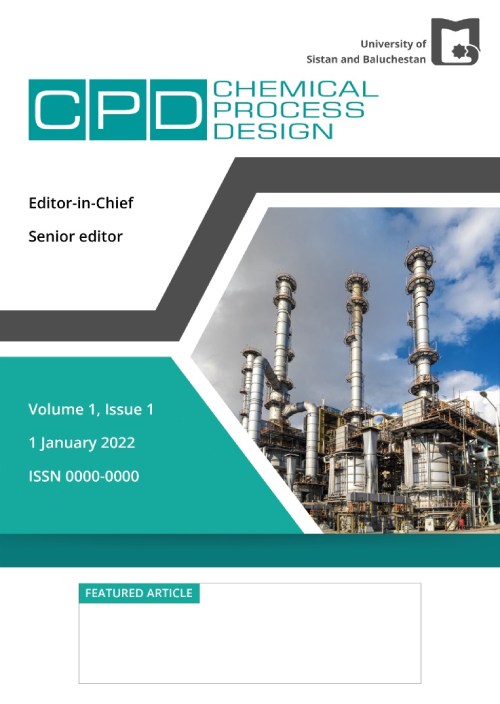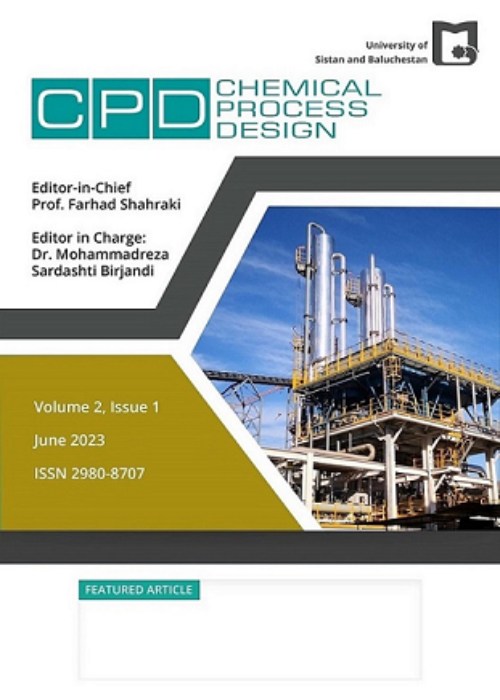فهرست مطالب

Chemical Process Design
Volume:1 Issue: 2, Dec 2022
- تاریخ انتشار: 1401/11/30
- تعداد عناوین: 6
-
Pages 1-13
Bubble dynamics is the most important sub-phenomenon, which basically affects the nucleate pool boiling heat transfer coefficient which includes bubble departure frequency, bubble diameter and nucleation site density. In this research, bubble departure frequency values were experimentally measured for heat fluxes up to 120 kW.m-2. Experiments were carried out for pool boiling of pure liquids, including water, ethanol and methanol on a horizontal smoothed cylinder, at atmospheric pressure. A high-speed digital video camera was applied to capture the dynamics of the bubble nucleation process. For ethanol and methanol, rigid spherical bubbles with small contact area were observed. The spherical shapes seem to be because of small diameters. For all test fluids, experimental results show that the bubble frequency increase with increasing heat flux. Increase in the rate of bubble generation, reduction in the waiting time and growth time can be the causes of this phenomenon. Also, experimental results show, Heat transfer coefficient increases with increasing heat flux for all test fluids at the experimental condition.
Keywords: heat transfer, Saturated Pool Boiling, Pure Liquid, Bubble Departure Frequency -
Pages 14-21Microbial fuel cell (MFC) is a technology of increasing interest recently. However, the lack of efficient and cost-effective membranes has hampered the commercialization of MFCs. polyether sulfone (PES) hollow fiber was utilized as the separator in the cylindrical ml-scale active–air MFC to treat domestic wastewater. The conventional aeration unit replaced with the silicon membrane tube that was only passed the oxygen of air across wall membranes and provides appropriate dissolved oxygen in the cathode chamber. The increase in hydraulic retention time (HRT) (from 1.43 to 3.97 min) drastically improved the power and current densities of the MFC from 306.41±17.43 to 540.98 ±32.00 mW/m2, and from 1842.138±103.18 to 2191.83±160.06 mA/m2, respectively. The electricity generation performance gradually continued to grow by further extending the HRT from 3.97 to 10.19 min. The maximum power and current densities of 582.97±28.61 mW/m2 and 2404.15±140.61 mA/m2 are obtained at the HRT of 10.19 min. Similarly, the coulombic efficiency as well as the current and voltage generation of the MFC is enhanced by the increment of HRT. The maximum open circuit voltage and current of 768±14.10 mV, and 0.418±0.004 mA (with the external resistance of 986 Ω) are yielded at the HRT of 10.19 min. The rather low response time which was obtained for this hollow fiber-MFC (450 min) shows its potential applicability as a biosensor.Keywords: Microbial fuel cell (MFC), Ultrafiltration Hollow fiber, Domestic wastewater treatment, Hydraulic retention time (HRT), Scale-down, biosensor
-
Pages 22-34
One of the favorite topics in the industrial and educational applications is external flows and the fluid and heat flows around a perpendicular cylinder, specially. This problem is greatly applicable in designing heat exchangers, fuel cooling, fuel elements and similar engineering equipment. In this study, the heat transfer in a laminar incompressible fluid flow around a cylinder that oscillate perpendicular to the flow direction, have been investigated. For this purpose, the OpenFOAM software has been used to solve the governing equations and obtaining the Nusselt number around this cylinder. Different Reynolds numbers, from 10 to 1000, and oscillation frequency ratios, from 0.8 to 1.2, have been investigated. The Nusselt number has been obtained in two effective Reynolds numbers and the changes in the Nusselt number and the pressure coefficient around the cylinder have been also calculated. The results show that increasing Reynolds number increases the heat transfer rate and the oscillation frequency ratio equal to 1 has the highest heat transfer rate.
Keywords: heat transfer, Oscillating cylinder, Nusselt number, Vortex Shedding -
Pages 35-47
Oily sludge is one of the major oil pollutants that bioremediation is considered the most efficient way of treating and removing harmful hydrocarbons from these pollutants. In this study, the biodegradation of oil sludge from the Sirjan Gasoil storage reservoir in the slurry phase was investigated. In this research, the effect of sewage (wastewater) and surfactant and their interactions on biodegradation in the slurry phase has been investigated. The oil sludge was mixed with a 25% (w/v) combined ratio with different liquids and the slurry phase was applied for 21 days by incubator shaker at 130, 150, and 190 rpm. The temperature of the specimens was set in the appropriate range for the activity of degrading bacteria (30°C). Determination of the amount of hydrocarbons by dichloromethane extraction was carried out every week and an incremental removal of hydrocarbon was observed during this period. Among the samples, the highest removal of hydrocarbons was attributed to a rotational speed of 190 rpm with a removal rate of approximately 55%.
Keywords: Bioremediation, Slurry phase, Oily sludge, Hydrocarbon, Wastewater, Tween 80 -
Pages 48-59
One of the most prevalent problems in the application of lubricants and hydraulic oils is sludge and varnish formation from lubricant degradation. It is believed that thermal degradation is the main reason for sludge formation in lubrication systems. In this study, base-stock lubricant (group I API) underwent the thermal degradation within a temperature range of 90 to 150°C for a period of 1 to 48 hours. In order to obtain a clear justification about lubricant degradation, a new analysis package of experiments consists of FTIR (Fourier Transform Infrared Spectroscopy), viscosity, TAN (Total Acid Number), IFT (Interfacial Tension measurement) and UC (Ultra-Centrifuge) test has been conducted. The results showed that the amount of sludge increases with temperature. Furthermore, all obtained results were analyzed theoretically. We found that when the surface tension suddenly decreases, the amount of sludge in the lubricant has reached its dangerous limit. Since the results of these analyses were a good predictor of sludge production, it can be claimed that the proposed package can be applied for prediction of sludge formation conditions.
Keywords: Lubricant Degradation, Condensation Products, Sludge, Analysis Package -
Pages 60-74
One of the critical elements of an adsorption desalination system is the adsorption bed. The system dynamics of a 2-bed single-stage silica gel plus water-based adsorption desalination system were analyzed. A great pattern was expanded using energy conservation and mass connected with the kinetics of the adsorption/desorption process. Computational fluid dynamics (CFD) modeling was used to simulate the adsorption process for a rectangular finned tube-based adsorption bed featured with silica gel adsorbent substance. The adsorbents in the simulation were considered solid volume with defined porosity based on the Darcy equation. The adsorption and desorption modes of the adsorption bed was simulated. CFD techniques were then applied to study fin thickness and height. The results showed that decreasing the fin thickness increased the water uptake by up to 8% and decreasing the fin height from 30mm to 20mm increased the water uptake by up to 17%. CFD technique was also used to investigate the effects of plate type on the adsorption bed performance. The results showed that the copper plate improved the water uptake up to 9%. The temperature decline of adsorption bed caused by the copper plate was up to 11% more than that of the aluminum plate.
Keywords: Adsorption bed, CFD, rectangular finned tube, fin thickness, plates type


